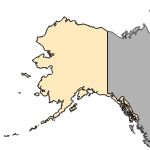Salvelinus alpinus oquassa
(blueback trout, Sunapee trout)
Fishes
Native Transplant |
|
Common name: blueback trout, Sunapee trout
Synonyms and Other Names: blueback char, golden trout
Taxonomy: available through
www.itis.gov
Identification: There has been considerable confusion and disagreement among taxonomists concerning the status of the Sunapee and blueback. For instance, some authors have treated each as distinct species, the blueback as Salvelinus oquassa and the Sunapee as S. aureolus. Quadri (1974) suggested that the Sunapee and blueback, along with the Quebec red (sometimes listed as S. marstoni), are conspecific and should be synonymized as a subspecies of the Arctic char (i.e., S. alpinus oquassa). According to Behnke (personal communication) both the Sunapee and blueback trout should be recognized as S. aureolus oquassa. Behnke later decided on a different name for this species. In his 2002 book, The Trout and Salmon of North America, Behnke listed Sunapee trout as Salvelinus alpinus oquassa, stating that it likely arrived in New England by crossing the North Atlantic during preglacial times and is probably more closely related to European subspecies of S. alpinus than it is to other North American subspecies. Kendall (1914) provided color plates showing both the Sunapee and blueback trout and gave a table to distinguish between the two forms. He also provided detailed descriptions and morphometrics. Scarola (1973) provided a key for the Sunapee trout. Everhart (1976) gave a photo of blueback trout and a key to both Sunapee and blueback trout.
Size: blueback - 36 cm; Sunapee - 58 cm (Kircheis 1976).
Native Range: Sunapee trout were native to Sunapee Lake, New Hampshire; Averill Pond, Vermont; Big Dan Pond, New Hampshire; and Floods Pond, Maine (Behnke, personal communication). Three of the four populations have become extinct and the Sunapee exists only in Floods Pond, Maine, near Bangor (Behnke, personal communication). The Sunapee populations have suffered due to hybridization with introduced lake trout S. namaycush (Behnke, personal communication). The blueback trout is native to northwestern Maine in the headwaters of the St. John and Penobscot rivers, specifically in Black Lake, Deboullie Lake, Gardner Lake, Purshineer pond in Arrostook County; Big Reed Pond, Rainbow Lake and Wadleigh Pond in Piscataquis County; Penobscot Lake in Somerset County (erroneously reported as in Piscataquis County); and in Bald Mountain Pond, also in Somerset County (Everhart and Waters 1965). Formerly existed in the Rangeley Lakes but extirpated from there circa 1904 (Kendall 1914; Everhart and Waters 1965).



|

Alaska |

Hawaii |

Puerto Rico &
Virgin Islands |

Guam Saipan |
Hydrologic Unit Codes (HUCs) Explained
Interactive maps: Point Distribution Maps
Nonindigenous Occurrences:
This species was introduced into several lakes at the headwaters of the Salmon River in Idaho, including Alice, Vernon, Big Redfish, and Sawtooth lakes (Linder 1963; Deacon et al. 1979; Idaho Fish and Game 1990). It was also stocked in four areas in Maine: Upper and Lower South Branch Pond in Piscataquis County, Echo Lake in Hancock County and Coffee Pond in Cumberland County (Maine Department of Inland Fisheries and Game 1974; Kircheis 1976). Each location received 5,000 fish annually from 1969 until at least 1974, except for Echo Lake which began stocking in 1974. This stocking was conducted as part of a management plan to increase the range of the Sunapee trout which has become restricted to one lake (Maine Department of Inland Fisheries and Game 1974). The Sunapee trout was introduced into unspecified area(s) of Massachusetts (Fowler 1907). The species was stocked in several lakes New Hampshire, including Tewskburry Pond in Grafton and Connor Pond in Ossippee (Scarola 1973; Kircheis 1976). Lake George (Warren County) in New York was stocked with trout from Sunapee Lake prior to 1903 (Bean 1903).
The Blueback trout was introduced into the Snake River drainage below Shoshone Falls, Idaho (Idaho Fish and Game 1990); unspecified areas of Maine shortly after the species discovery in 1874 (Kendall 1914; Kircheis 1975). Although presumed native, the population at Wadleigh Pond, Maine, might have resulted from these early introductions. An experimental translocation from Wadleigh Pond to Basin Pond in Kennebec County, Fayette Township, Maine, was carried out in 1969 (Kircheis 1975). The blueback trout was also stocked in Newfound, Squam, Connor, and Sunapee lakes, New Hampshire, in 1879, and in unknown locations the previous year (Kendall 1914; Hoover 1936; Kircheis 1975). Stocking in Sunapee Lake took place several years before the Sunapee trout was identified (Kendall 1914).
Table 1. States with nonindigenous occurrences, the earliest and latest observations in each state, and the tally and names of HUCs with observations†. Names and dates are hyperlinked to their relevant specimen records. The list of references for all nonindigenous occurrences of Salvelinus alpinus oquassa are found here.
Table last updated 1/13/2026
† Populations may not be currently present.
* HUCs are not listed for states where the observation(s) cannot be approximated to a HUC (e.g. state centroids or Canadian provinces).
Means of Introduction: Most of these introductions took place a hundred years ago and were intended to enhance sportfishing. Blueback stockings in Maine and New Hampshire were mainly as forage for landlocked salmon (Kircheis 1975). Beginning in the late 1960s, fish originating from Floods Pond were transplanted to several other ponds and lakes for conservation (Frost 2001)
Status: Established in Idaho (in Sawtooth Lake) (Behnke, personal communication); failed in New Hampshire, New York, and Massachusetts. Early blueback stockings in Maine and New Hampshire failed (with the possible exception of Wadleigh Pond (Kircheis 1975). Experimental stockings of bluebacks in Basin Pond failed (Kircheis 1975).
Impact of Introduction: The impacts of this species are currently unknown, as no studies have been done to determine how it has affected ecosystems in the invaded range. The absence of data does not equate to lack of effects. It does, however, mean that research is required to evaluate effects before conclusions can be made.
References: (click for full references)
Behnke, R.J. 2002. Trout and salmon of North America. The Free Press, New York, NY.
Deacon, J.E., G. Kobetich, J. D. Williams, S. Contreras, and other members of the Endangered Species Committee of the American Fisheries Society. 1979. Fishes of North America Endangered, Threatened, or of Special Concern: 1979. Fisheries 4(2):29-44.
Everhart, W.H., and C.A. Waters. 1965. Life history of the blueback trout (Arctic char, Salvelinus (Linnaeus)) in Maine. Transactions of the American Fisheries Society 94(4):393397.
Frost, F.O. 2001. Arctic char management plan. Maine Department of Inland Fisheries and Wildlife, Ashland, ME.
Kendall, W.C. 1914. The fishes of New England. The salmon family. Part I - the trout or charrs. Memoirs of the Boston Society of Natural History 8(1): 1-103.
Kircheis, F.W. 1975. Draft blueback trout management plan. Maine Department of Inland Fisheries and Game, Division of Fisheries and Planning.
Linder, A.D. 1963. Idaho's alien fishes. Tebiwa 6(2):12-15.
Quadri, S.U. 1974. Taxonomic status of the Salvelinus alpinus complex. Journal of the Fisheries Research Board of Canada 31(8):1355-1361.
Scarola, J.F. 1973. Freshwater fishes of New Hampshire. New Hampshire Fish and Game Department, Division of Inland and Marine Fisheries.
Other Resources:
FishBase Summary
Author:
Pam Fuller, Matt Cannister, and Matt Neilson
Revision Date: 12/29/2025
Peer Review Date: 4/17/2012
Citation Information:
Pam Fuller, Matt Cannister, and Matt Neilson, 2026, Salvelinus alpinus oquassa (Bean, 1887): U.S. Geological Survey, Nonindigenous Aquatic Species Database, Gainesville, FL, https://nas.er.usgs.gov/queries/FactSheet.aspx?SpeciesID=936, Revision Date: 12/29/2025, Peer Review Date: 4/17/2012, Access Date: 1/13/2026
This information is preliminary or provisional and is subject to revision. It is being provided to meet the need for timely best science. The information has not received final approval by the U.S. Geological Survey (USGS) and is provided on the condition that neither the USGS nor the U.S. Government shall be held liable for any damages resulting from the authorized or unauthorized use of the information.